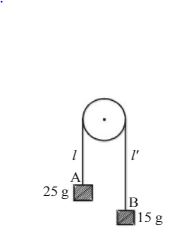A horizontal force F is applied on back of mass m placed on a rough inclined plane of inclination θ. The normal reaction N is
-
Solution

In the system shown in figure, the pulley is smooth and mass less, the string has a total mass 5g, and the two suspended blocks have masses 25 g and 15 g. The system is released from state ι = 0 and is studied up to stage ι’=0 During the process, the acceleration of block A will be

-
Solution
Considering the two masses and the rope a system,then
Initial net force =[25 - (15 + 5)] g = 5g
Final net force = [(25 + 5) - 15] g = 15 g
⇒(acceleration)final= 3 (acceleration)initial
A plate of mass M is placed on a horizontal of friction less surface (see figure), and a body of mass m is placed on this plate. The coefficient of dynamic friction between this body and the plate is μ . If a force 2μmg is applied to the body of mass m along the horizontal, the acceleration of the plate will be

-
Solution
The frictional force acting on M is µmg
∴ Acceleration = µmg⁄M
A ball of mass 0.4 kg thrown up in air with velocity 301 ms-1 reaches the highest point in 2.5 second . The air resistance encountered by the ball during upward motion is
-
Solution
Let the air resistance be F. Then
mg + F = ma ⇒ F = m[a - g]
Here a = 30⁄2.5 = 12 ms-1
A 10 kg stone is suspended with a rope of breaking strength 30 kg-wt. The minimum time in which the stone can be raised through a height 10 m starting from rest is (Take g = 10 N/kg)
-
Solution

On a smooth plane surface (figure) two block A and B are accelerated up by applying a force 15 N on A. If mass of B is twice that of A, the force on B is

-
Solution
The acceleration of both the blocks = 15⁄3x =
5⁄x∴ Force on B =5⁄x × 2x = 10N
An object is resting at the bottom of two strings which are inclined at an angle of 120° with each other. Each string can withstand a tension of 20 N. The maximum weight of the object that can be supported without breaking the string is
-
Solution
If W is the maximum weight, then
W = 2T cos 60°
or W = T = 20N
A particle moves so that its acceleration is always twice its velocity. If its initial velocity is 0.1 ms–1, its velocity after it has gone 0.1 m is
-
Solution

In the figure a smooth pulley of negligible weight is suspended by a spring balance. Weight of 1 kg f and 5 kg f are attached to the opposite ends of a string passing over the pulley and move with acceleration because of gravity, During their motion, the spring balance reads a weight of

-
Solution

A block of mass m on a rough horizontal surface is acted upon by two forces as shown in figure. For equilibrium of block the coefficient of friction between block and surface is

-
Solution
Here, on resolving force F2 and applying the concept of equilibrium

N = mg + F2 cos θ, and f = µN
∴ f=µ [mg + F2 cos θ ] …(i)
Also f = F1 + F2 sin θ …(ii)
From (i) and (ii)
µ [mg + F 2 cos θ] = F1 + F2 sin θ
\(\Rightarrow \mu =\frac{F_{1}\, +\, F_{2}\, sin\, \theta }{mg\, +\, F_{2}\, cos\, \theta }\)




